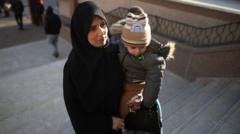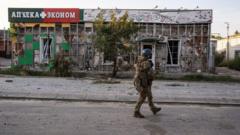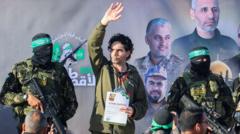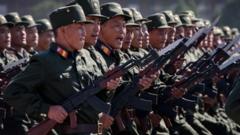As a tenuous cease-fire holds in Gaza, devastation reigns alongside the celebration of orchestrated hostage releases, sparking a complex mix of joy and sorrow as communities grapple with the impacts of prolonged conflict.
Cease-Fire in Gaza: A Balance of Hope and Despair

Cease-Fire in Gaza: A Balance of Hope and Despair
Cease-fire brings both relief and mourning as Gazans Survey Destruction, Israelis Await News of Hostages
While Gazans sift through the ruins left by 15 months of violence, residents on both sides are eagerly watching the unfolding aftermath of a cease-fire intended to mark a beginning of peace. The fragile truce, initiated on Sunday, has already prompted a significant exchange of prisoners between Hamas and Israel, fueling both hope and anxiety across communities.
As families reconnected following the release of three Israeli hostages on Sunday—who were met with jubilation upon their return—90 Palestinian prisoners were freed in the West Bank, igniting celebrations there as well. Yet, these moments of joy are shadowed by the vast destruction evident in Gaza, where entire neighborhoods have been reduced to rubble. Residents are left to mourn not only the physical loss of their homes but also the grim realities of survival amidst ongoing uncertainty regarding future hostages and humanitarian needs.
International observers are shifting focus toward the human cost of the conflict, as humanitarian aid begins trickling back into Gaza after months of blockade and war. Despite this initial influx, critics caution that sustainable solutions necessitate unrestricted access to essential supplies for over two million displaced residents.
The emotional landscape reflects deep societal divides, with some families in Israel expressing unresolved concern over remaining hostages held by Hamas, while Palestinians grapple with a humanitarian crisis exacerbated by wartime devastation and loss. Additionally, the dynamics of the cease-fire and its potential longevity hinge on the unfolding negotiations set to address the release of remaining captives as well as the complexities surrounding the future governance of Gaza.
In a time fraught with tension, officials from both camps express hope as they navigate these precarious exchanges, yet the haunting echoes of war linger heavily over the region, emphasizing the need for both healing and reconciliation as preparations for the next phase of dialogue commence.
As Israel and Hamas pursue a long-term resolution, the narratives of both despair and relief continue to unfold, shaping a new chapter in a narrative marked by seemingly endless cycle of conflict and its devastating repercussions.
As families reconnected following the release of three Israeli hostages on Sunday—who were met with jubilation upon their return—90 Palestinian prisoners were freed in the West Bank, igniting celebrations there as well. Yet, these moments of joy are shadowed by the vast destruction evident in Gaza, where entire neighborhoods have been reduced to rubble. Residents are left to mourn not only the physical loss of their homes but also the grim realities of survival amidst ongoing uncertainty regarding future hostages and humanitarian needs.
International observers are shifting focus toward the human cost of the conflict, as humanitarian aid begins trickling back into Gaza after months of blockade and war. Despite this initial influx, critics caution that sustainable solutions necessitate unrestricted access to essential supplies for over two million displaced residents.
The emotional landscape reflects deep societal divides, with some families in Israel expressing unresolved concern over remaining hostages held by Hamas, while Palestinians grapple with a humanitarian crisis exacerbated by wartime devastation and loss. Additionally, the dynamics of the cease-fire and its potential longevity hinge on the unfolding negotiations set to address the release of remaining captives as well as the complexities surrounding the future governance of Gaza.
In a time fraught with tension, officials from both camps express hope as they navigate these precarious exchanges, yet the haunting echoes of war linger heavily over the region, emphasizing the need for both healing and reconciliation as preparations for the next phase of dialogue commence.
As Israel and Hamas pursue a long-term resolution, the narratives of both despair and relief continue to unfold, shaping a new chapter in a narrative marked by seemingly endless cycle of conflict and its devastating repercussions.






















